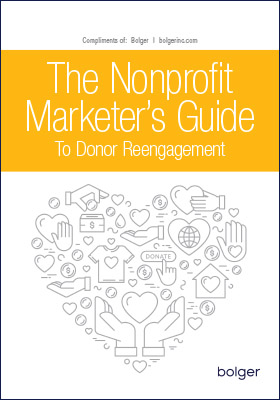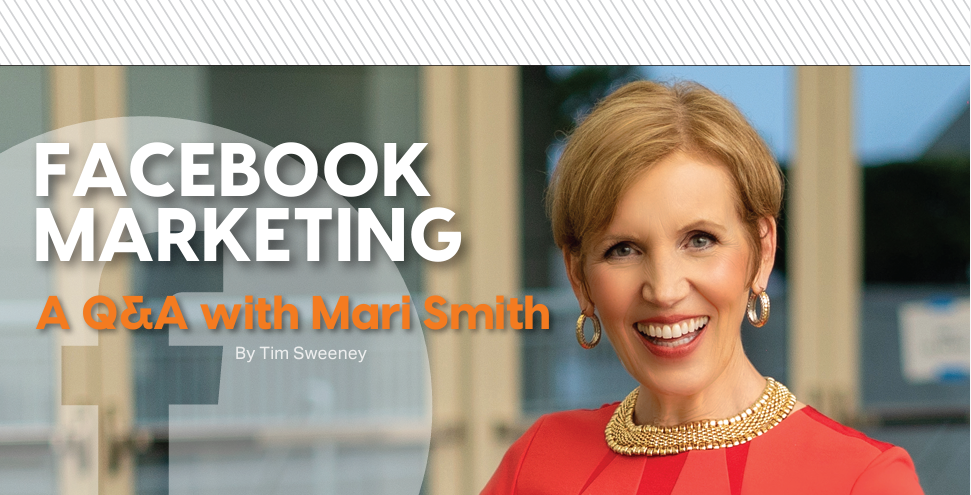“Class is in session as the Queen of Facebook Marketing explains how to target your audience, the best-performing content types, what metrics to rely on, how to deal with those pesky algorithms, and much more.
The key to Facebook marketing is to really understand your audience deeply, craft compelling offers, refine your ad copy, and ensure the targeting is on point by testing what performs well.”
That’s the advice of Facebook marketing expert Mari Smith, and she knows of what she speaks. Smith travels the country and the globe sharing her acquired wisdom on social media marketing. Her expertise on the world’s biggest social platform has earned her the moniker the Queen of Facebook Marketing. Co-author of Facebook Marketing: An Hour a Day and author of The New Relationship Marketing, Smith also created the report Top Five Facebook (& Instagram) Marketing Challenges with Solutions based on a survey she conducted with 2,000 of her email subscribers.
In case you thought Facebook was just for your mom and dad, Smith is quick to point out that Facebook still offers the most sophisticated ad targeting parameters due to the inordinate amount of data the company gathers from its users. There’s also this: Facebook reached 2 billion daily active users worldwide at the end of 2022 and had 2.9 billion monthly active users in March 2023. Meta Platforms, Inc.—Facebook’s parent company, consisting of Facebook, Instagram, and WhatsApp—reached a new milestone in Q1 2023, with 3 billion people using at least one of its apps each day. What does all that mean?
“Facebook is still the king of all social networking platforms and is a solidly viable marketing channel,” Smith says.
We managed to pose some questions to Smith when she could spare time between consulting and training independent professionals, entrepreneurs, and business owners on how to accelerate their business profits using an integrated social marketing strategy.
Q: Let’s start with strategy. Any basic advice for small businesses trying to build their own Facebook marketing strategy?
Mari Smith: Companies starting their Facebook presence can focus on a modest advertising budget and not worry about going through all the hoops to garner impressive public-facing metrics. These are all proxy metrics—number of followers, engagement, reactions, shares, comments, and video views. Sure, we need some proxy metrics, but don’t stop there. The business metrics are more important, and you can jump straight to those with properly deployed ad campaigns, even if you only have 10 followers.
(See the sidebar for Mari’s more detailed three-step plan for building your Facebook marketing strategy.)
Q: Facebook marketing seemingly includes a million tactics and content types (e.g., Reels, organic copy and video, groups, contests and giveaways, Messenger chatbots). Do companies need to use them all, or can they start with a few?
MS: I’m a big proponent of leveraging as much organically as possible. Of course, it can depend on the size and age of your Facebook business Page, but I would tap into everything Facebook offers for free as well as deploy well-planned and well-executed ad campaigns. There is one type of post that can do extremely well in terms of organic reach and engagement on Facebook, and that is plain text on a background color, especially when you ask a question. Facebook provides this post format inside Meta Business Suite. Although it might look like an image post with large text, the algorithms read it as a plain text post, and it really stands out in the feed. I recommend using this format a few times a week with a compelling question to spark engagement.
Q: Are there any rules these days for what types of Facebook posts seem to perform the best for marketers?
MS: There are no real prescriptive approaches to identifying top-performing posts on Facebook, because what works for one Page doesn’t necessarily work for another. Typically, the lowest-reaching post type is the one marketers want to publish the most: straight link posts with the link preview. So, get creative here. Try an image post or video post and include your call to action and link in the description, or test putting it in the first comment. In general, be sure to add captions to video and speak in conversational tones. If you’re using stock images or video clips, strive to pick people who look like your customer personas. Don’t always think more is better when it comes to posting frequency of organic content. Focus on quality over quantity, and derive more ROI out of each post by going deeper with your audience.
Q: Meta seems to be rewarding marketers who consistently use its short-form, vertical Reels on Facebook and Instagram. What’s driving this?
MS: Yes, they are. This is a valiant attempt to compete as much as possible with TikTok and woo the younger demographics back to Facebook. Certainly, the more that marketers can embrace the Reels format on Facebook, the potentially greater reach and discoverability they can achieve. That is, their Reels content can be discovered by a cross section of their audience simply through Facebook’s AI-powered discovery engine that recommends content for users in their feeds.
Q: It’s easy to scroll past ads on Facebook because we see so many of them. Any tips on how a company can improve its customer acquisition on Facebook?
MS: One of the most important aspects of effective ad campaigns is to craft your content to seamlessly fit into posts we see from friends so that your ads do not feel interruptive to users. In fact, Facebook Cofounder and CEO Mark Zuckerberg and Former COO Sheryl Sandberg stated back in 2014 that their goal was not so much to increase the quantity of ads on Facebook, but to improve the quality of ads so they felt as relevant and as timely as the content your friends shared. This idea is still very much on point for advertisers today. I recommend testing the lead-generation ads through the prepopulated form and/or via responses on Messenger, Instagram Direct, or WhatsApp. This approach works very well for customer acquisition with well-targeted campaigns and compelling creative, because nearly 70 percent of Facebook users in the United States access the platform via their mobile devices.
Q: The beauty of social media is that a brand’s owned channels are measurable. What should marketers be measuring to gauge the ROI of their social media marketing?
MS: I put social media metrics into two categories. The first is proxy metrics (growth in followers, reach, and all engagement, such as reactions, shares, comments, video views, Reel plays, and more). Brands do need to keep a watchful eye on this set of numbers, but the second category—what I call your business metrics—is even more important. These are traffic, leads, conversions, and sales. These metrics demonstrably move the needle to grow your business. The CEO and CFO of any company needs to know both sets of metrics, but with a heavy emphasis on translating exactly how the proxy metrics are actually helping grow the business. Some businesses and brands may not have impressive public-facing engagement metrics, and that’s okay, because we never know what they might be doing behind the scenes with paid campaigns to drive significant traffic, leads, and sales. It’s true that anyone can look at any Facebook business Page and see what ads they’re running, but you can’t see the results of the ads or all the parameters.
Q: Regarding ad spend, how can novice Facebook marketers know that their money is being used smartly and that they are not being “duped” by the Facebook ad machine?
MS: First, knowing your customer acquisition cost (CAC) and customer lifetime value (CLTV) is critical, whether spending money on Facebook ads or not. Then, with this knowledge, one of the primary objectives of testing and refining your ad campaigns is to get the cost per lead as low as possible whilst maintaining a high-quality lead whenever possible. To do this, test the lead-generation ad unit but include, say, two to three qualifying questions. This way, you’re not just collecting first names and emails. If your offer is for B2B, you could also gather pertinent information related to the size of their business, the person’s role, the number of employees, or any relevant information that will “force” the prospect to jump through just a couple of hoops to get the desired complimentary offer in exchange for filling out the form. In general, whenever running ad campaigns on the Meta platforms, keep a very watchful eye on your metrics. Set spending limits; don’t just set and forget—as much as Meta would love you to do that!
Q: Facebook and other social platforms seem to constantly evolve their algorithms to manipulate what we see. How do you advise companies to keep up with them?
MS: When Facebook invented the concept of the news feed in September 2006, users revolted at the idea of the platform picking content for them to see. But all these years later, the feed concept has been emulated across nearly every social platform, and we’ve become used to it. Depending on how many friends a user has, groups they’ve joined, and Pages they follow, there could be as much as 1,500 possible posts to see in the feed. So it’s a good thing that these algorithms whittle down the choices and have come to know us so well as to select content that we might be interested in. What changed dramatically in the past year or so is something that Meta, yet again, blatantly copied from TikTok—the concept of the “discovery” or “recommendation” engine, where the AI-powered algorithms have gathered so many data points on each user that they can very accurately suggest content that Meta calls “unconnected.” Connected content is from people, groups, and Pages we have proactively chosen to follow, but unconnected content is from all manner of random sources that you’ve never heard of. However, it’s actually not so random. These algorithms are very good at predicting what you might like.
Q: Is this good news for marketers?
MS: Yes, because now you have an increased chance of your content potentially being seen by an audience that may never have come across your Page otherwise. About 20 percent of all the content that users see in their main feed today is from people and pages they are not connected to. We do have the option of viewing content just from individual feeds, such as Favorites, friends, groups, and Pages. I think Facebook just threw us a bone with those extra feeds; they’re visible mostly on mobile. In any case, companies don’t really have to keep up to speed on every algorithmic nuance, because in today’s world, organic reach is still very low—about 6 percent for Facebook business Pages. Some Pages may experience a lift in reach by publishing more Reels.
Q: Audience Insights inside Meta Business Suite is a little-known resource for marketers. How do you advise brands use it?
MS: They really ought to tap into it. You can see the current demographics of your followers on both Facebook and Instagram, and the data provided can be helpful to simply inform you on whether your ideal customer persona is following you and if there are other types following you. The insights show age, gender, top cities, and top countries. Then you can also start drilling into the demographics of your potential audience across all Facebook, worldwide. By adjusting the filters, you can see at a glance the audience size and demographics of specific interests and potentially use this in your ad targeting. Brands and marketers would definitely do well to use these Audience Insights tools to get a better sense of the potential performance
of their ad campaigns.
Q: Can you really acquire leads through Facebook?
MS: Absolutely. Businesses and brands of all sizes acquire leads on a daily basis through effective Facebook advertising. A great example is Carol Tuttle, a best-selling author and creator of the online makeover system Dressing Your Truth. She and her team do an excellent job of offering compelling lead magnets and engaging organic content as well as consistently running targeted ad campaigns, all of which generate qualified leads and sales.
Q: Should marketers combine Facebook with other social media for best results? If yes, what other social platforms complement Facebook?
MS: Yes, 100 percent. Never, ever rely exclusively on just one platform, even Facebook, with its almost three billion monthly active users. I strongly recommend also including Instagram in your marketing mix, then at least one non-Meta-owned platform. So that would be YouTube for sure, and most every brand ought to have an active presence on LinkedIn, especially if you’re in a B2B environment. Perhaps include TikTok, if it’s a match for your target demographic and on-brand for your needs. Twitter seems to be an acquired taste these days but can still provide upside.
Q: Finally, AI is all the rage at the moment, and Meta tells us that AI can be a valuable tool to marketers on its platforms—supercharging brand creative, etc. How do you see AI changing Facebook marketing strategies going forward?
MS: Mark Zuckerberg announced back in February that Meta has a new “turbocharged” focus on AI. One of the key areas Meta is working on is baking generative AI into its current products, giving users the ability to create written, image, and video content without leaving Facebook or Instagram. I predict that before long, we’ll be able to create AI-powered content right inside Meta Business Suite. Zuckerberg often feels like he’s behind when there’s a big-sea change happening, so the company will hustle and forge ahead very quickly to play catch-up. Meta has actually led the way with some AI-powered developments over the years, such as its algorithmically controlled feeds. However, generative AI is a whole new arena for many social platforms and businesses alike.
Want a helpful marketing guide?
Our helpful marketing guide will be mailed to you for FREE.
Get a Free Marketing Guide








